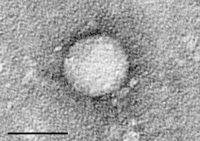
Photo from wikipedia
“Core areas” of transmission for bacterial sexually transmitted infections have been identified. However, it is unclear whether core areas apply to viral infections, such as hepatitis C virus (HCV). We… Click to show full abstract
“Core areas” of transmission for bacterial sexually transmitted infections have been identified. However, it is unclear whether core areas apply to viral infections, such as hepatitis C virus (HCV). We used geographic mapping and spatial analysis to identify distinct core areas of HCV infection in British Columbia (BC) using the BC Hepatitis Testers Cohort (BC‐HTC), 1990‐2013. The BC‐HTC includes all BC residents tested for HCV (~1.5 million; 1990‐2013). Core HCV infection areas were identified spatially and temporally for five time periods (1990‐1993, 1994‐1998, 1999‐2003, 2004‐2008 and 2009‐2013) through thematic mapping, Kernel Density Estimation, Hotspot analysis and cluster analysis at the Census dissemination area level in ArcGIS and SatScan. HCV infection core areas were consistently identified. HCV core areas expanded from the downtown of major cities in different regions of BC (Metro Vancouver, Vancouver Island, and Northern BC; 1990‐1998), to smaller cities in Metro Vancouver and Interior BC (2000 onwards). Statistically significant clusters, or hotspots, were also observed for downtown Vancouver, Northern BC (Prince George) and Vancouver Island from 1990 to 2008 with expansion to other urban areas in Metro Vancouver from 1990‐2013. Statistically significant clusters persisted after adjustment for injection drug use, number of HCV tests, age, sex, material and social deprivation. Persistence of areas with high HCV diagnoses rates in Vancouver and Prince George supports the theory of core areas of HCV transmission. Identification of core areas can inform prevention, care and treatment programme interventions and evaluate their impact over time.
Journal Title: Journal of Viral Hepatitis
Year Published: 2019
Link to full text (if available)
Share on Social Media: Sign Up to like & get
recommendations!